The National World War II Museum opened on June 7, 2000, the 56th anniversary of the invasion of Normandy. University of New Orleans historian and author Stephen Ambrose founded the museum, and named it the National D-Day Museum, after its focus on those historic battles (Dumond, Chris 7 Jun 2009. “New Orleans World War II museum finds tourism niche.” The News and Advance. Lynchburg, VA. http://web.ebscohost.com.libproxy.tulane.edu (accessed August 5, 2009)). In 2004, the U.S. Congress made it the official United States National World War II Museum (Forster, Mary 25 May 2008. “As WWII vets pass, memories preserved.” Associated Press. New Orleans, LA. http://global.factiva.com (accessed September 15, 2009)). The museum changed its name in 2006 to reflect its new mission (Dumond). Although it began with a focus on collecting and preserving World War II memorabilia and chronicling the D-Day invasions, it widened its scope to cover the events of the whole war, particularly concerning the United States’ involvement (Forster). The museum employs a wide array of media including photographs, films, and artifacts from the war that is focused on communicating the many aspects of the war such as the events that led up to it and the D-Day invasion of Normandy.
Purpose
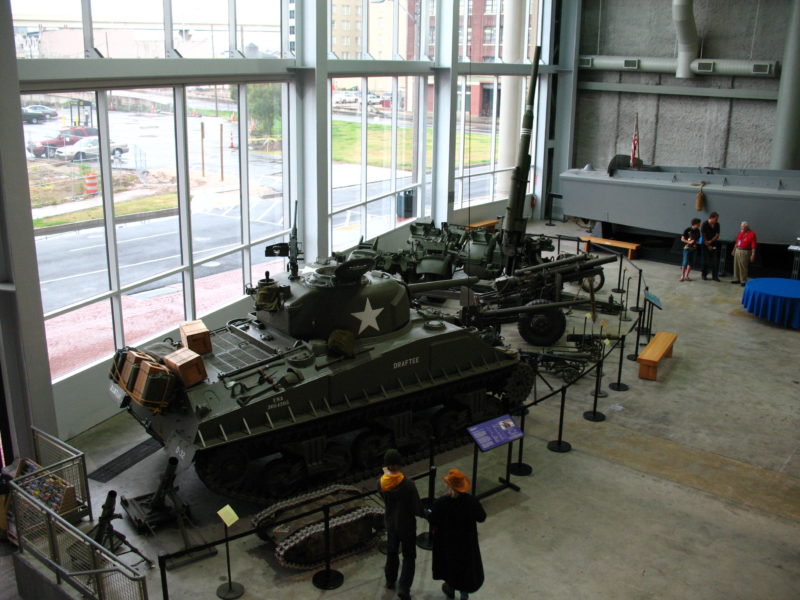
Tanks on display. Photo by Bogdan Migulski via Flickr.
The National World War II Museum is a tribute to the American soldiers who served in the war. It also credits the women who assisted in the war as nurses and in other valuable positions, and places a particular emphasis on the local wartime efforts; for example, the museum has a permanent exhibit that focuses on the construction of Higgins landing crafts built in Louisiana and used in the D-Day invasions. These landing crafts were very important in the D-Day coastal invasions because they allowed soldiers to reach the shore without having to swim, which would have made the soldiers more vulnerable to attack. The museum memorializes the service of all of the Americans who contributed to the nation’s efforts in World War II by detailing their efforts in the war both overseas and on the home front that helped lead to the Allied victory. The museum highlights the role of minorities, especially African Americans, who helped in the war effort, both on the home front and on the battle front. The museum has focused on the D-Day invasions both because they were central to the Ally victory because they allowed the Allies to invade and gain foothold in the areas that were occupied by Axis force, and because the locally built Higgins landing crafts were crucial to the invasions’ success.
History
The National World War II Museum first found funding in a $270 billion military defense bill that also appropriated funds for other military museums. A guide at the museum stated that the government chose to build it in New Orleans because of the importance of the Higgins landing crafts to the success of the Allies. The bill allocated $11 million for work on all of the museums, which included the building of an airborne and special operations museum at Fort Bragg, N.C., and of a naval undersea museum in Keyport Washington. The bill appropriated $4 million for what was then to be called the National D-Day Museum (Burns, Robert 23 Nov 1991. “Senate Gives Final OK to $270 Billion Defense Bill.” Associated Press. Washington D.C. http://global.factiva.com (accessed September 10, 2009)). The 1993 Budget passed by Congress in May 1992 included the $4 million funding for the museum. The museum coordinators set the proposed opening day for the museum on June 6, 1994, the 50th anniversary of D-Day. The museum was to be built on a Pontchartrain Beach property right next to the University of New Orleans.
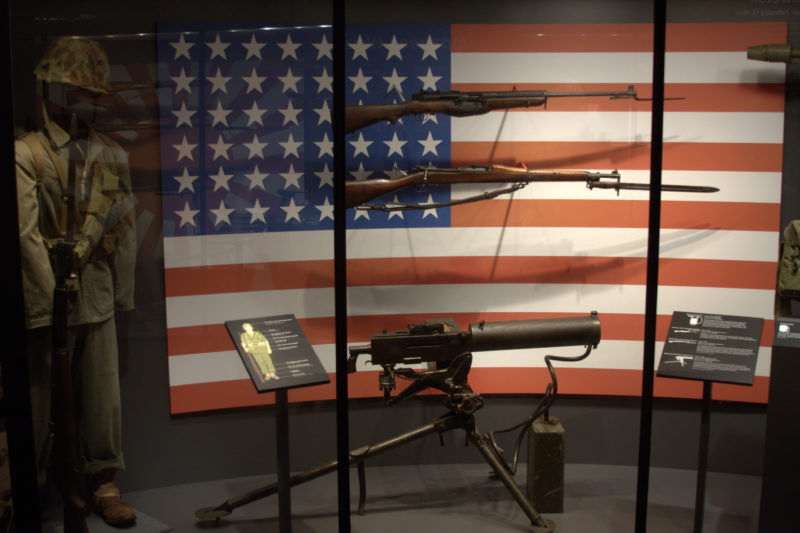
An equipment exhibit. Photo by Pravin Premkumar via Flickr.
Stephen Ambrose proposed several exhibits in the museum plan that never made it to the final museum, which included a Higgins landing boat ride and an outdoor exhibit on the beach that included airplanes and tanks. Ambrose wanted to make a museum that was “lively” and “hands-on,” and he most of all expressed the desire for children to be able to experience it and be shown what America did in World War II, to see the fury of an aroused democracy (Darby, Joe 23 May 1992. “Grant OK’d for D-Day Museum U.S. Money Raises Hopes for Complex on Lakefront.” Times-Picayune. New Orleans, LA. http://global.factiva.com (accessed September 10, 2009)). Museum officials decided against the Pontchartrain Beach location due to a lack of major tourist traffic in the area, and they later decided upon Lee circle which is located in the Warehouse District of New Orleans. This area was deemed more appropriate due to its proximity to other tourist attractions, such as the Contemporary Arts Center and the Confederate Museum, as well as to the Ernest N. Morial Convention Center and Interstate 10 (Darce, Keith 13 May 1996. “D-Day Museum could Land Near Lee Circle.” New Orleans CityBusiness. New Orleans, LA. http://global.factiva.com (accessed September 10, 2009)).
Location
The National World War II Museum is located at 945 Magazine Street in New Orleans. This area is known as both the Warehouse District and the Arts District, and it is home to numerous art galleries, as well as multiple museums (Arts District (Warehouse District). http://www.neworleansonline.com/tools/neighborhoodguide/artsdistrict.html (accessed August 5, 2009)). The current building contains several exhibits. The museum houses four separate areas for exhibits; their respective titles are “The Home Front”, “Planning for D-Day,” “The D-Day Beaches” and “The D-Day Invasions in the Pacific.” While the former three areas opened along with the museum, the Pacific D-Day area of the museum opened on December 7, 2001, the sixtieth anniversary of the invasion of Pearl Harbor (9 Dec 2001. “Profile: Sunday Morning Diversion; new exhibit on D-Day invasions of the Pacific opens at the National D-Day Museum.” CBS News: Sunday Morning. http://global.factiva.com. (accessed September 29, 2009)). A separate section called the Louisiana Memorial Pavilion is located at the entrance to the museum, and it contains many larger artifacts such as tanks and fighter planes, as well as a working reproduction of a Higgins landing craft.
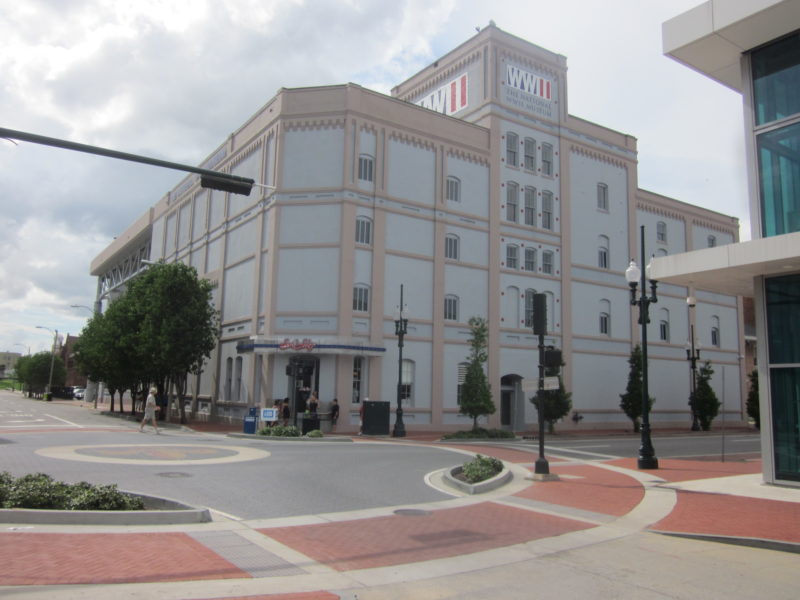
The museum sits in the Central Business District just across from Magazine Street. Photo provided by Infrogmation of New Orleans via Flickr.
The museum also has an area for temporary exhibits, the Malcolm S. Forbes Theater (Exhibits. http://www.nationalww2museum.org/exhibitions/ (accessed August 5 2009)). An upcoming $300 million expansion will quadruple the size of the museum. The additions will open successively between 2009 and 2014. According to the museum, it will add “four prominent exhibit pavilions which will portray all campaigns of the war on land, sea, and air, and each branch of the U.S. military services, a theater and [United Service Organizations] entertainment venue, a themed restaurant, and a public parade ground” (The Road to Victory Capital Expansion. http://www.nationalww2museum.org/expansion/ (accessed August 5 2009)). The new theater, to be called Victory Theater will first showcase a Tom Hanks executive produced film called “Beyond All Borders.” The film will tell the story of soldiers beginning with the invasion of Pearl Harbor and focusing on many of the battles of the war, all from the perspective of United States World War II veterans. The film is described as a 4-D experience, meaning that it is projected in three dimensions and uses additional effects that interact with audiences, such as life-sized props, that supplement the images on the screen. The theater, along with the American Sector restaurant and the Stage Door Canteen entertainment and dining venue open on November 8th 2009 (The National WWII Museum Presents The Victory Theater. http://www.nationalww2museum.org/victory-theater/ (accessed September 29 2009)).
Exhibits and Media Use
The museum currently hosts several different exhibits primarily focusing on the beginning of World War II and the D-Day invasions. These exhibits use many types of media and artifacts including audio recordings of former soldiers, weapons, military vehicles, and documentary video recordings. The exhibits in the museum are laid out mostly in chronological order from the build up to the war to the victory in the Pacific, but the timelines of some exhibits overlap each other.
Video and Audio Recordings
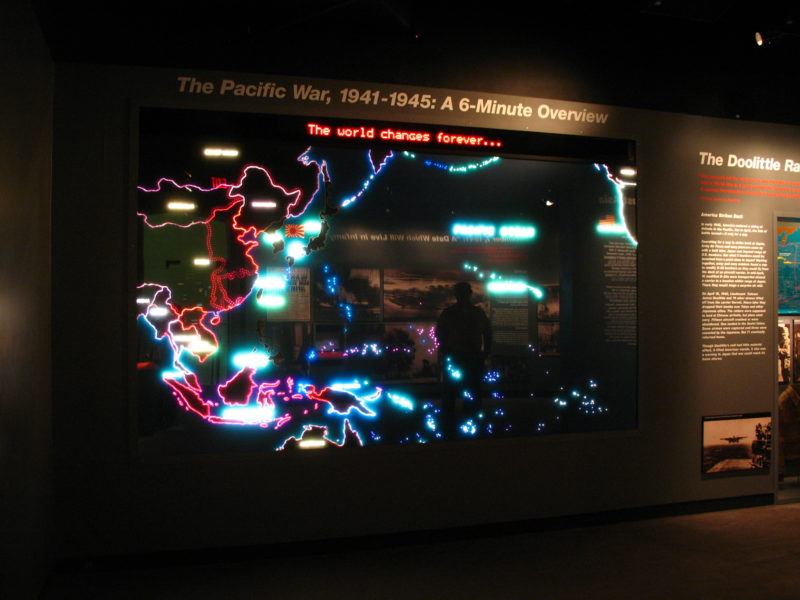
A video display summarizing the Pacific War. Photo by Bogdan Migulski via Flickr.
The video recordings in the museum mainly consist of historical footage with narration, but there are other videos that supplement audio recordings of oral histories. Many of the audio tracks stand on their own, but most of them are accompanied by photographs of the people whose stories are recorded. Ambrose recorded most or all of the oral histories in the museum. Most of the oral histories are those of veterans, although the museum also has recordings voiced by actors of translated journals of Nazi soldiers, as well as recordings of Higgins builders. The museum holds a large amount of these audio recordings in storage, and only a small number are currently exhibited. The recordings that are on exhibit complement the exhibits in which they are placed; for example, the Higgins exhibit contains recordings of people who helped build the landing craft.
Artifacts
The museum contains numerous material artifacts, such as barracks and training videos that show what life was like for a soldier. Other artifacts include weapons from the United States military as well as the Japanese and German forces, supplies made for the troops, United States and German military uniforms, pro-war advertisements, and propaganda from both the United States and Japan. Many of the artifacts were donated to the museum. Over the years, Ambrose met with thousands of veterans and recorded the aforementioned oral histories, and many of these men were major contributors of the artifacts in the museum (Martel, Brett 14 Oct 2002. “Historian Stephen Ambrose dies at 66 of cancer.” Associated Press. New Orleans, LA. http://global.factiva.com (accessed September 29, 2009)). Numerous artifacts remain in storage, and a great amount of them will be displayed in the new sections of the museum. These material artifacts help visitors to understand what life was like for soldiers in the war. There are less weapons in the Pacific exhibits than the European exhibits, which the museum explains is due to the fact that the jungle terrain in the Pacific made certain weapons less effective, so they were not used in that area. Because the museum explains this, visitors get a more developed understanding of the differences between the way the war was fought in different locations.
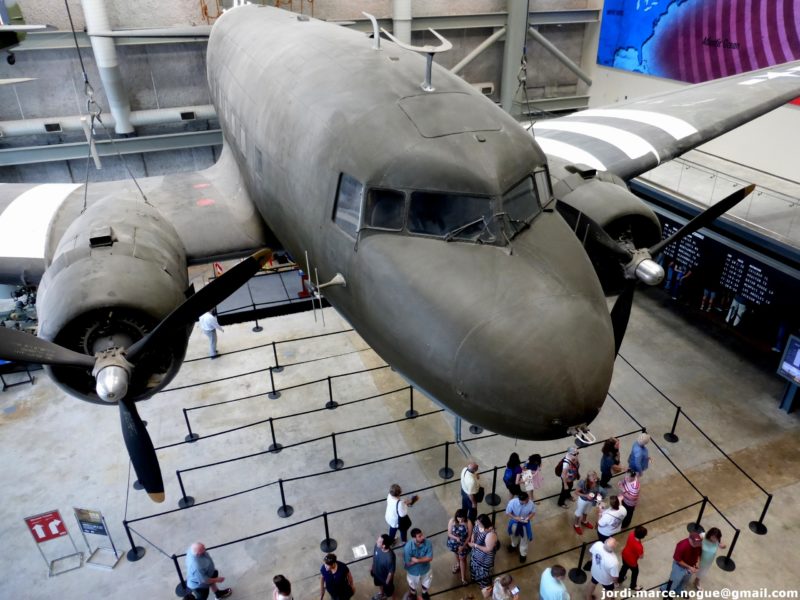
An authentic war plane perches over crowds in the museum. Photo by Jordi Marcé-Nogué via Flickr.
One exhibit in the home front area of the museum contains several large piles of supplies and displays figures representing the increase in production from pre-war to wartime years. This shows visitors the immense scale of factory production that went into producing supplies for the soldiers. Propaganda images in the Pacific D-Day exhibit help show the way that both the United States and Japan fueled resentment in their societies for each other with the use of hateful and racist images. Many of the propaganda images from Japan lampooned FDR, portraying him in perceptibly hideous and humorous ways. In some propaganda images, his skin was a different color and his appearance was altered to be grotesque. The American propaganda images mostly played upon racist stereotypes of Japanese people, implying that they were inferior, comical, or violent. One image likens Japanese people to animals, and multiple images express that Japanese people are dangerous, particularly to white women. These images also serve as a representation of both of these nations’ tolerance for racist types of images around the time of the war.
Photography
The most highly used form of media in the museum is photographs. Many of the photographs are largely printed and most are in black and white. The photographs in the Pacific exhibit are printed in sepia tone, which differentiates them from the photographs in the rest of the museum that are printed in standard black and white, and helps visitors visually distinguish the exhibit from the first three areas of the museum. The photographs in the museum are primarily a mixture between aerial and long distance views of major battles and more close-up views of soldiers or groups of soldiers. These photographs help the viewer to see both the immense scale of the war and the personal struggles of the people who contributed to the war effort. Other photographs highlight the leaders of the major powers involved in the war, including Franklin Delano Roosevelt and Adolf Hitler.
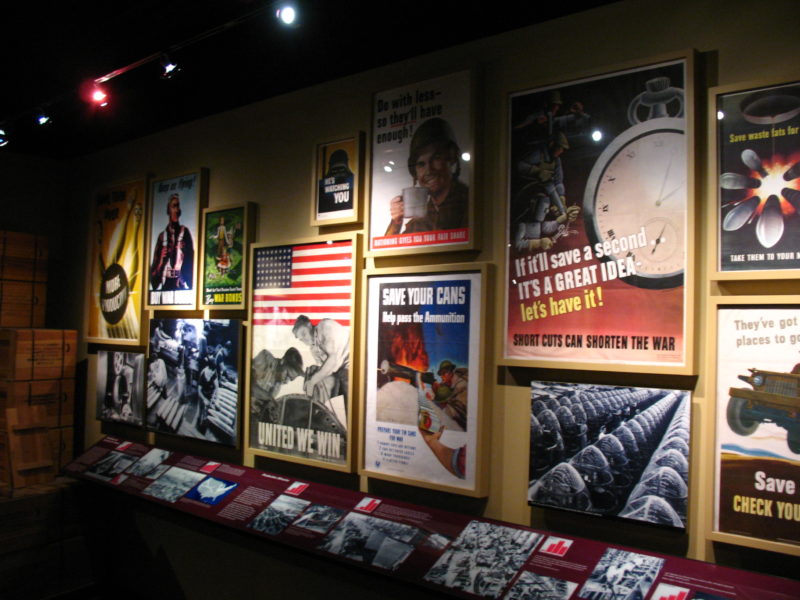
Part of an exhibit on pro-American Propaganda. Photo by Bogdan Migulski via Flickr.
The museum also displays World War II related advertisements and newspaper articles from the United States that show both the pro-war media campaigns that helped foster public support for the war, and media coverage of important events such as the attack on Pearl Harbor and the Allied defeat of Japan. Many of the advertisements and articles are significantly enlarged from their original versions, which helps attract attention to them, and for the newspaper articles also allows several people to read them simultaneously since they can be read from a distance. One large photograph near the end of the successive European D-Day invasion area stands out because the museum chose to print it in color. It is a photograph of a cemetery in Europe with numerous gravestones of fallen United States soldiers that fill the image. This photograph helps the viewer to begin to comprehend the vast amount of casualties suffered in the war.
High-Tech Media
Both the European and Pacific exhibits use high-tech forms of media to demonstrate specific aspects of the D-Day invasions. In the European D-Day exhibits, video recordings that display on the floor show the plans for the invasions using visuals of maps and objects such as airplanes and ships that represent the troops that were preparing to invade. The objects move along the map to show the course of the troops as they storm the beaches in Europe. In the Pacific D-Day exhibit, there is a large map that displays the movement of the battlefront in the Pacific from 1941 to 1945. This exhibit uses lights that turn on and off sequentially to show the movement of troops in the Pacific and how they used the strategy of island hopping to invade Japanese-controlled territories. The islands are permanently lit on the map, but the lights representing the troops light up in sequence as the troops move through the Pacific. A bright light flashes from above during this exhibit to represent the detonation of the first atomic bomb.
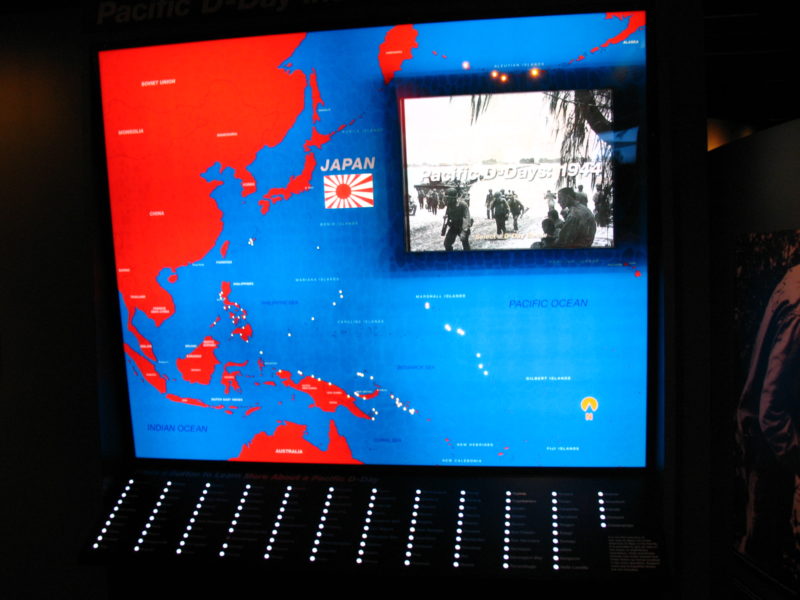
Interactive Map of the Pacific. Photo by Bogdan Migulski via Flickr.
There is another map in the Pacific section of the museum that is interactive. It has 115 buttons that correspond with different D-Day invasions, and a light activates when a button is pressed to show where the invasion was. A monitor displays a description that corresponds with the selected D-Day invasion. The museum explains that it created this interactive map to show visitors the immense number of D-Day attacks that occurred in the Pacific. These high-tech forms of media help engage viewers in the story the museum is trying to tell by showing the movement and distribution of troops on the battle front in a different and possibly more engaging way than more traditional media forms such as printed maps or regular video recordings would be able to depict them.
Historical Documents
The museum contains several documents that are historically significant concerning the United States’ effort in World War II. These documents include a reproduction of a note Roosevelt wrote to himself the day of the Normandy invasion, telegraph messages from the United States military to Higgins, the boat manufacturer, a letter written Eisenhower wrote to invading troops at the beginning of the Normandy invasion, and blueprints of a Higgins landing craft. The documents from the time of the Normandy invasion help show the reader the importance and anxiety surrounding the invasion; for example, Roosevelt wrote in his note that he accepted blame if the mission failed and that he was acting on the best intelligence available. The blueprints of the landing craft and the messages to Higgins help paint a picture of the story of the development of the Higgins landing crafts and why they were crucial to the Ally victory in the war. The messages to Higgins show the dialogue that went on between the time the military gained interest in Higgins’ boats and when he delivered the first boat for testing.
Events
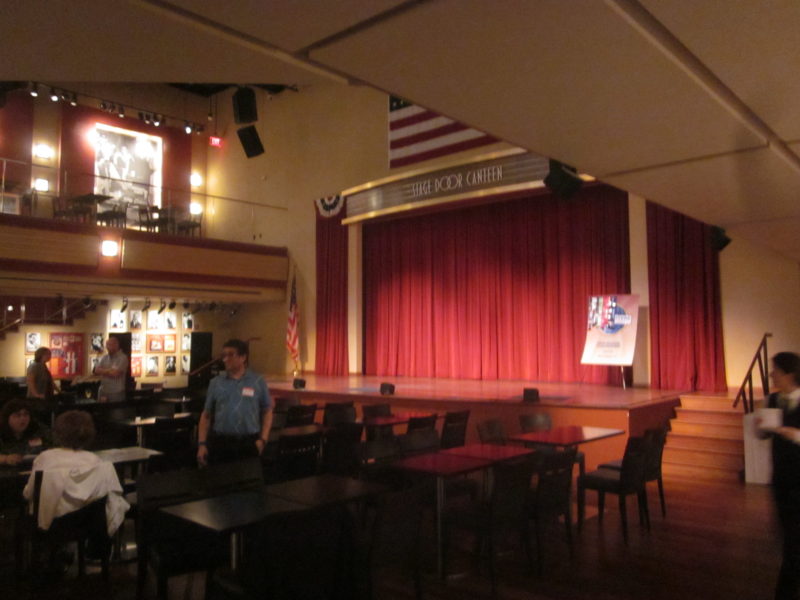
The Stage Door Canteen Stage. Photo provided by Infrogmation of New Orleans via Flickr.
Many of the events held at the museum highlight soldiers, both those in service and veterans. On the anniversary of D-Day in 2009, the museum hosted a ceremony called “A Gathering of the Greatest Generation, a Roll Call of the American Fighting Man of World War II,” for which the museum invited World War II veterans and their families to attend (6 Jun 2009. âD-Day Remembered at World War II Museum. Voice of America. Houston, TX. http://global.factiva.com (accessed September 15, 2009)). On Armed Forces Day in May 2006, the museum held a celebration featuring musical programs and performances by both the 313th U.S. Army Reserve Brass Band Quintet and the 313th Army Show Band which are both from Birmingham, AL, as well as a lecture and book signing by Neil Hanson, author of the book Unknown Soldiers, a story about World War I soldiers (http://www.nationalww2museum.org/media/15th-anniversary.html). The National World War II Museum serves as a venue for World War II lectures from prominent speakers. It has hosted the General Raymond E. Mason, Jr. Distinguished Lecture Series, which has featured several speakers, including NBC newscaster Tom Brokaw, World War II veteran and Presidential Medal of Freedom recipient John W. Vessey, historian and author Alex Kershaw, and several other speakers (http://www.nationalww2museum.org/learn/public-programming/lectures/stephen-ambrose.html).












